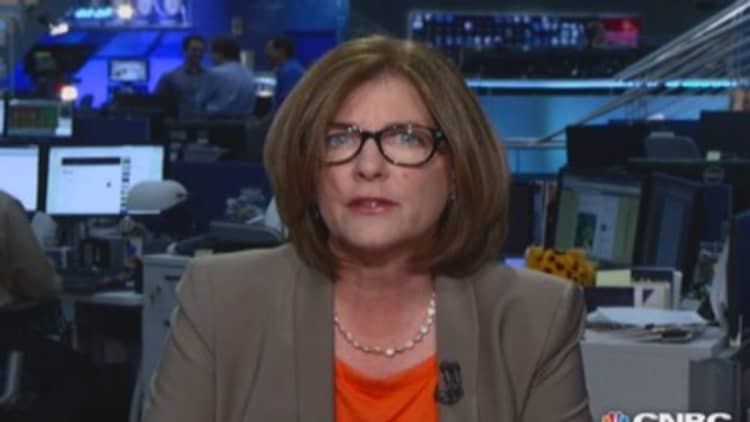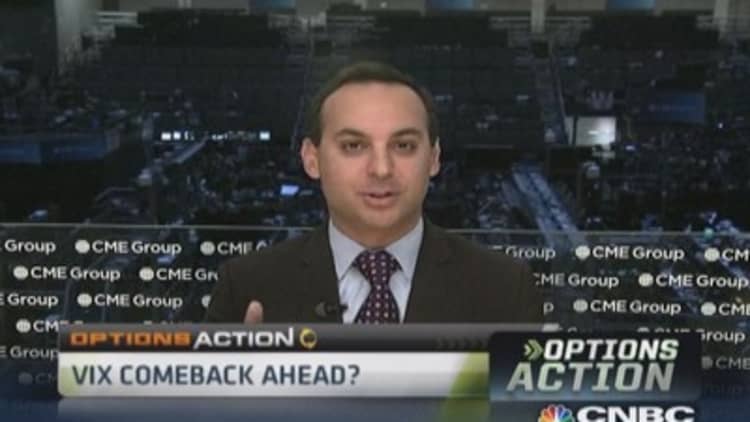
After languishing as stocks reached record highs, the VIX has sprang back to life—bringing with it a dose of fear for the stock market.
The VIX, the Chicago Board of Options Exchange's volatility index, jumped nearly 10 percent during Tuesday's session after a similar move Monday. Stocks sold off sharply with the higher beta small cap Russell 2000 and Nasdaq leading the declines and momentum names taking the brunt of selling.
The IBB, the iShares Nasdaq Biotech ETF, fell 2.1 percent, but social media stocks were hit even harder. LinkedIn was off 6 percent and Twitter was off 7 percent. GoPro, which rocketed from its IPO price, lost 4 percent. Netflix was down 3.4 percent, and Pandora was down 7.3 percent.

The closed down 0.7 percent, and buyers moved into bonds, with the 10-year yield slipping back to 2.55 percent from 2.62 percent. Utilities was the best performing of the big cap sectors, up 1 percent, and telecommunications was the weakest, down 1.5 percent
The VIX, which measures the relative levels of put and call buying in the S&P 500 near-term options, was at 12.51, but ended up closing at 11.98, up 5.7 percent. It is still at a historically low level.
"It's going with the selloff," said one S&P options trader. "There were some option buyers out of the gate this morning and that was the big thing. …They were buying really short-dated options."
Read MoreThis will either make stock rally sizzle or snap
July VIX futures rose closer to the August futures price, a sign to some traders that the volatility could continue for a while.
"What the markets telling you is this period of extremely low volatility is perhaps over," said Andrew Wilkinson, chief market analyst at Interactive Brokers.
"People are tired of fighting the trend of falling volatility for so long that they've given up on the trade. It's the time in the calendar when investors normally load up on protection, as earnings start to roll out and for fear of any type of market correction – sustained or otherwise," he added.
The stock market selloff comes as market talk about the Fed winding down its easing program has picked up. The Fed is seen finishing its bond purchases under the quantitative easing program sometime in the fall and then it is seen turning its attention to rate hikes, expected next year.
Thursday's stronger-than-expected jobs report for June raised speculation the Fed would move to hike rates earlier in the year, rather than later.
"I think you're seeing a significant break in the secondary market and it's working its way int the larger cap area," said Dan Deming, who trades the VIX with Stutland Volatility Group. "You're seeing significant weakness for the first time in several weeks, and that's playing on the mindset now, where you're seeing the VIX push up into the 12 area."
"We are seeing some activity roll out into September, one of the bigger trades this morning," said Deming. "They're keeping their long exposure to volatility."
Read MoreStocks skid before earnings; Nasdaq falls nearly 2%
Deming said if the market begins to expect 1 percent daily moves in the S&P 500, the VIX would head to 16, at a minimum. "We've had a pretty subdued volatility structure and market pattern for a couple of months now," he said, adding July is the most volatile month for the VIX.
Over the past 20 years, the VIX has had the biggest percent change in July. On average, it has been moved nearly 9 percent for the month, with September the second most volatile at 8 percent.
Geopolitical tensions are also playing a role in the risk-off trade. Israel's offensive in the Gaza is raising concerns of further escalation, and headlines about air raid sirens in Tel Aviv added to the anxiety.
"And you've got the Fed," Deming added. "That's ultimately going to enter into it. The Fed is going to basically be done with it [quantitative easing]." Focus would then shift to rate hikes, he said.
"How is the market going to find its stabilizer after that? ... Everybody's aware that's out there, but no one wants to flinch because the market's behaved so well in the last couple of years."
Traders said the uncertainty about the Fed is a factor in the selloff, particularly after Goldman Sachs and others earlier this week moved forward expectations for the first rate hike. Goldman now says mid-2015 is when the Fed could move, a time frame already expected by others. But Goldman economists had previously not been expecting a hike until early 2016.
Wal-Mart added to the gloom after U.S. CEO Bill Simon said the recovering labor market hasn't been enough to spur consumers to increase spending.
A story about the Fed fueling asset bubbles, leading The New York Times on Tuesday, was also viewed as a negative for sentiment but not viewed as new information.
Weakness in bank stocks was credited to concerns about reports of the government's investigation into Commerzbank, also in the Times.
But traders said the market also was just simply overbought.
Read MoreMomentum names slammed as volatility comes back
"The relative strength index on NDX [Nasdaq] was at the highest since 2012 Thursday. That tells you the market is stretched," said Peter Boockvar, chief market analyst with Lindsey Group.
—By CNBC's Patti Domm


